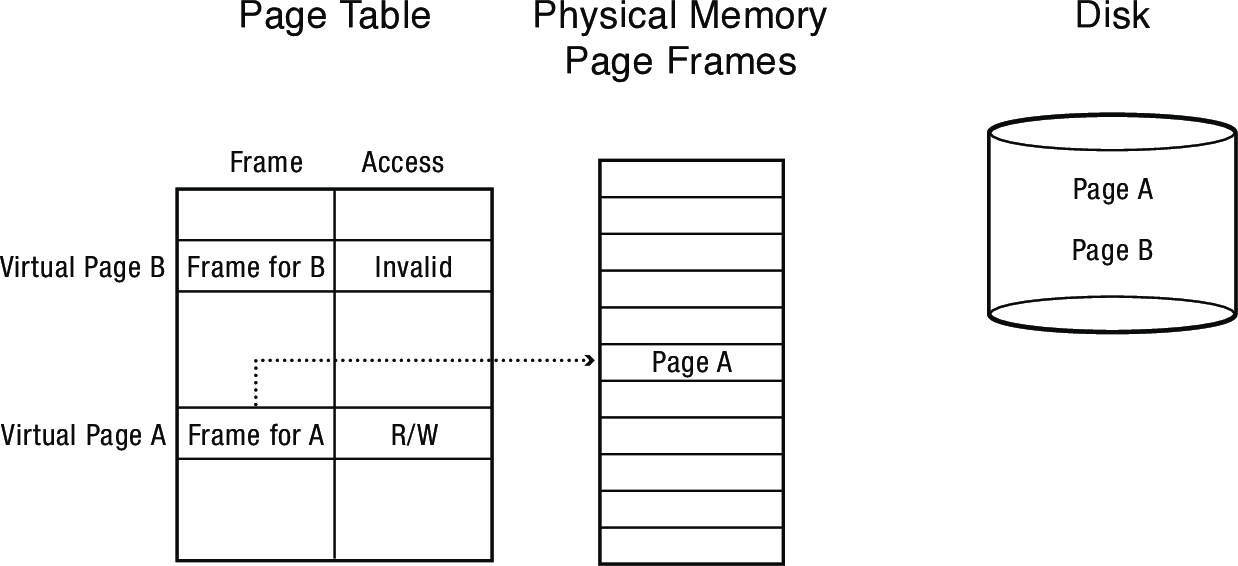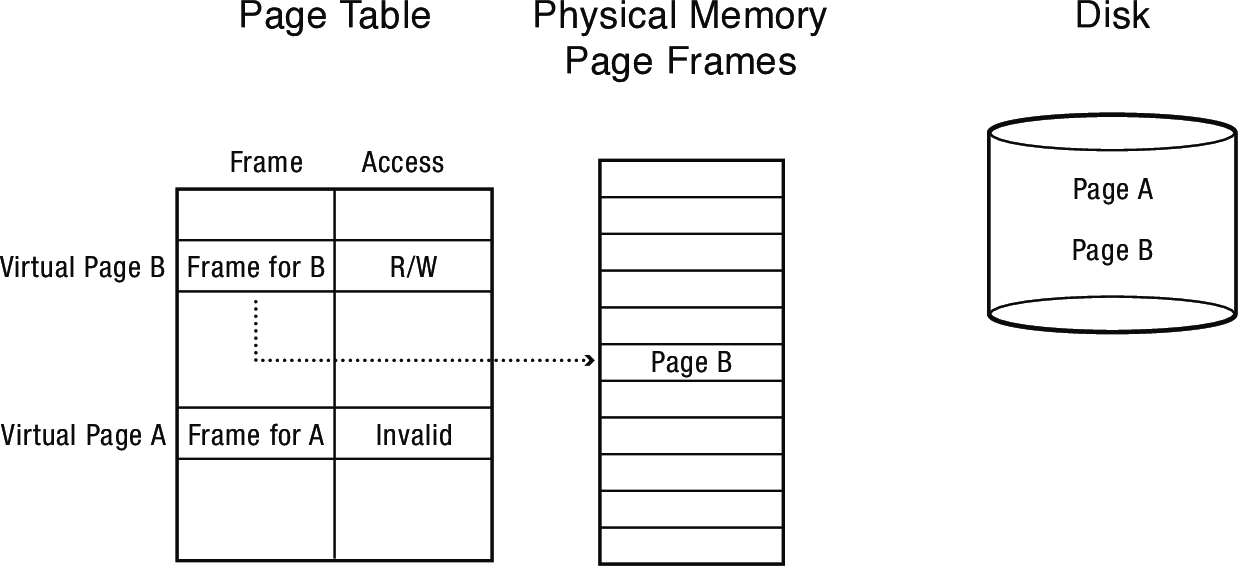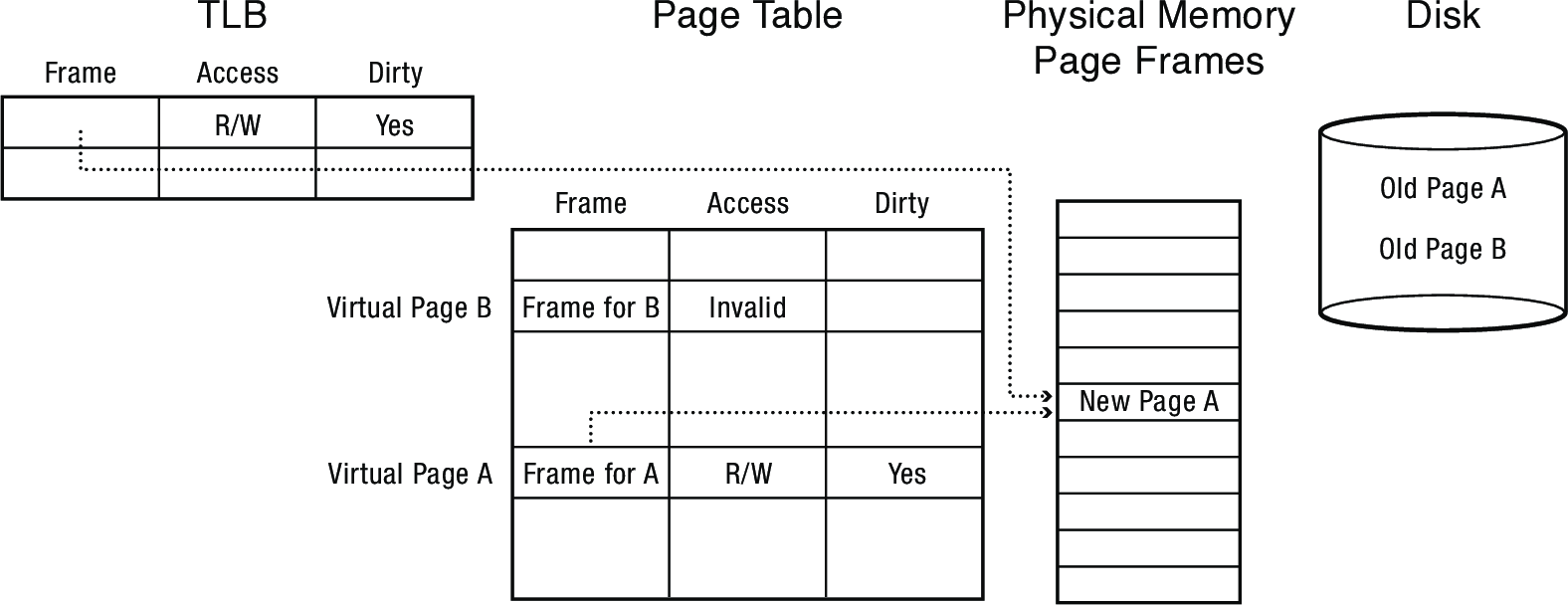CS 332 w22 — Beyond Physical Memory
Table of Contents
- 1. (near) Infinite Memory
- 2. Demand Paging
- 3. Memory-Mapped Files
1 (near) Infinite Memory
- Can we provide the illusion of near infinite memory in limited physical memory?
- What's a source of storage that's much bigger and cheaper than memory? The disk!
- We will treat memory as a cache for the disk
- This will enable
- Demand-paged virtual memory, a general technique
- Memory-mapped files, a technique for efficient I/O
- Address translation will be a crucial tool, allowing kernel to intervene when accessing selected addresses
2 Demand Paging
- Illusion of (nearly) infinite memory, available to every process
- Multiplex virtual pages onto a limited amount of physical page frames
- Pages can be either
- resident (in physical memory, valid page table entry)
- non-resident (on disk, invalid page table entry)
- On reference to non-resident page, copy into memory, replacing some resident page
- From the same process, or a different process
- A generalization of the on-demand paging from earlier
- Could start running a program after initializing the first code page, loaded others in the background or as needed
- Space on disk reserved for non-resident spaces is called swap space
What happens when a process accesses virtual page B?


2.1 How does the kernel provide the illusion that all pages are resident?
- TLB miss
- Page table lookup
- Page fault (page invalid in page table)
- Trap to kernel
- Locate page on disk
- Allocate page frame
- Evict page if needed
- Initiate disk block read into page frame
- Disk interrupt when read complete
- Mark page as valid
- Resume process at faulting instruction
- TLB miss (entry still not present in TLB)
- Page table lookup to fetch translation
- Execute instruction
2.2 Where are non-resident pages stored on disk?
- Option: Reuse page table entry
- If resident, entry contains the physical page frame number
- If non-resident, entry contains a disk block reference
- Option: Use file system
- Maintain a per-segment file in file system, offset within file corresponds to offset within segment
2.3 How do we find a free page frame?
- If there's an unused page, use it
- Otherwise, select old page to evict
- Find all page table entries that refer to old page
- If page frame is shared (use a core map, linking physical page → virtual pages)
- Set each page table entry to invalid
- Remove any TLB entries (on any core)
- Why not: remove TLB entries then set to invalid?1
- Write changes on page back to disk, if necessary
- Why not: write changes to disk then set to invalid?2
2.4 Which pages have been modified (must be written back to disk)?
- Every page table entry has some bookkeeping
- Has page been modified?
- Safe, but inefficient: treat every page as modified
- Better: dirty bit
- Set by hardware on store instruction
- In both TLB and page table entry
- Has page been modified?
- Bookkeeping bits can be reset by the OS kernel
- When changes to page are flushed to disk
- Memory is a write-back cache for the pages on disk


2.5 What policy should we use for choosing which page to evict?
- Random
- For first-level caches, speed may be paramount, and cost of making a wrong choice is small
- Avoids any bookkeeping overhead
- Unlikely to make the worst choice, but lack of predictable behavior could prevent optimization
- FIFO
- Treat cache entries as a queue, always evict the oldest one
- MIN
- Replace the cache entry that will not be used for the longest time into the future
- Optimality proof based on exchange: if evict an entry used sooner, that will trigger an earlier cache miss
- Least Recently Used (LRU)
- Replace the cache entry that has not been used for the longest time in the past
- Approximation of MIN
- Least Frequently Used (LFU)
- Replace the cache entry used the least often (in the recent past)
2.5.1 Approximating LRU
- Hardware does not track exact LRU information
- Would prohibitively expensive (e.g., update a linked list on every memory access)
- Instead, tracks whether a page been recently used
- Use bit
- Set by hardware in page table entry when entry brought into TLB
- How accurately do we need to track the least recently/least frequently used page?
- If miss cost is low, any approximation will do
- Clock algorithm
- OS periodically sweeps through all pages, reclaiming unused, clearing use bit
- Nth chance: not recently used
- Count number of sweeps since last use, reclaim page once count reaches N
3 Memory-Mapped Files
- Explicit read/write system calls
- Data copied to user process using system call
- Application operates on data
- Data copied back to kernel using system call
- Memory-mapped files
- Open file as a memory segment
- Program uses load/store instructions on segment memory, implicitly operating on the file
- Page fault if portion of file is not yet in memory
- Kernel brings missing blocks into memory, resumes process
- Advantages
- Programming simplicity, especially for large files
- Operate directly on file, instead of copy in/copy out
- Pipelining
- Process can start working before all the pages are populated
- Interprocess communication
- Shared memory segment will be more efficient than a shared temporary file
- Programming simplicity, especially for large files
Linux system calls:
void *mmap(void *addr, size_t length, int prot, int flags, int fd, off_t offset); int munmap(void *addr, size_t length);
- Memory-mapped file is a (logical) segment
- Per segment access control (read-only, read-write)
- File pages brought in on demand
- Using page fault handler
- Modifications written back to disk on eviction, file close
- Using per-page dirty bit to determine if writing is necessary